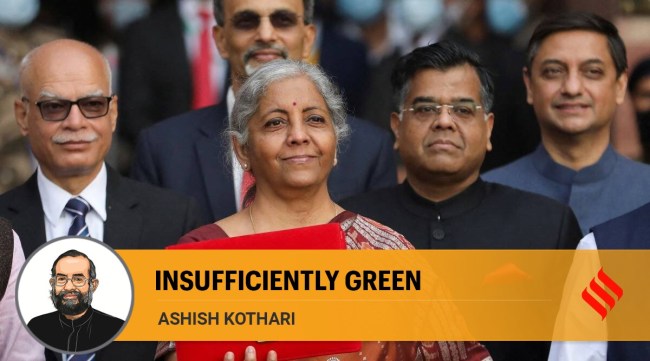Opinion Despite its stated aim, budget falls short on green ambitions
Ashish Kothari writes: There is a massive rise in allocation for infrastructure projects, with huge environmental implications, and little set aside for sustainable development
 Finance Minister Nirmala Sitharaman leaves her office to present the Budget in Parliament in New Delhi, February 1, 2022. (Reuters Photo)
Finance Minister Nirmala Sitharaman leaves her office to present the Budget in Parliament in New Delhi, February 1, 2022. (Reuters Photo)
Three things stand out in the 2022-23 Union budget for anyone interested in the relationship between economy and ecology. One is the complete absence of the following words in Finance Minister Nirmala Sitharaman’s budget speech: Nature, wildlife, environment, ecology, ecosystem, pollution, and conservation (except uses such as “business environment” and “growth ecosystem”). Second, it is a budget with a stated focus on climate action. Third, there is a massive rise in allocation for infrastructure projects, with huge environmental implications. Seen together, these highlights demonstrate the deep contradictions in the government’s approach to sustainable development.
One can analyse the budget from three standpoints: Direct allocations for the environment sector, allocations for environment in non-environment sectors, and allocations for other sectors with environmental impacts.
On the first count, there is a slight increase in the budget of the Ministry for Environment, Forests and Climate Change (MoEFCC) from 2021-22’s revised estimate of Rs 2,870 crore to Rs 3,030 crore. But this is easily wiped out by inflation. More importantly, this is a meagre 0.08 per cent of the total budgetary outlay. While some sectors like forestry and wildlife have seen a healthy rise in allocation, the outlay for others like the National River Conservation Plan has declined – this, astonishingly, also includes the allocation for tackling air pollution, widely acknowledged as a national emergency.
On the second count, there is mixed news. There is a welcome stated focus on natural and organic farming, and on promoting millets. But there are no details on the allocations, including for linkages necessary to make such farming viable, such as manure and markets. Also, given the major push for food processing in the budget, without making reservations for community-run businesses, there is a danger of big corporations capturing the organic space. Completely missing is a focus on rainfed farming that involves 60 per cent of the farming population and is ecologically more sustainable than artificially irrigated agriculture. The FM announced the government’s support to “chemical-free farming throughout the country,” but she has also allocated a massive chemical fertiliser subsidy of Rs 1,05,222 crore. A chance to begin shifting this subsidy to organics has been missed.
On the climate front, there are several positive provisions — use of biomass for power stations, boost to batteries, energy-efficiency measures in large commercial buildings, and sovereign green bonds. However, these gains will be more than wiped out by the much greater budgetary support to climate-unfriendly investments like those on mega-infrastructure, air travel, and coal expansion.
Renewable and “clean” energy has received substantially higher allocations. But the focus remains on mega-parks in solar/wind energy, nuclear power, and large hydro that have serious ecological impacts. These projects also threaten to grab peoples’ lands. The additional budget for farm-level solar pumps and rooftop solar generation is welcome, but it’s minuscule compared to mega-projects. Another chance to shift towards decentralised renewable energy with less ecological impacts and greater community access has been missed.
There is a striking schizophrenia in the government acknowledging climate as the “strongest negative externality” but investing hardly anything in coping mechanisms for hundreds of millions of people facing the consequences of increased floods, fires, droughts, coastal erosion, cloudbursts, unpredictable rainfall, and temperature extremes. The National Climate Action Plan gets an abysmally inadequate Rs 30 crore — the same as in 2021-22. And there is no focus on a “just transition” that could help workers in fossil fuel sectors, like coal, to transition to jobs in cleaner, greener sectors.
It is encouraging to see the budget proposing a “paradigm shift” towards sustainable urban living. A committee is to be set up to advise on this. The budget does promise greater support for public transport, something demanded by citizens’ groups for decades. Unfortunately, most of the allocation in this will go to metros that are extremely carbon-intensive in terms of construction. The budget misses out on the shift towards a full bus system, cycling and walking – which would help both the environment and most road users in cities. Even the boost to electric vehicles is likely to benefit the rich unless it is predominantly focused on buses.
The third dimension is of greatest concern. As highlighted by the FM, this is predominantly an “infrastructure budget”. While investments in infrastructure for small towns and villages are urgently needed, much of what is proposed are mega-projects. The proposed 25,000 km increase in highways will further fragment forests, wetlands, mountains, grasslands, agricultural lands and bypass most villages. A shift in paradigm to decentralised, sustainable, and community-oriented infrastructure is missing.
Several specific allocations are of further concern. For instance, the Ken-Betwa river-linking project, given over Rs 40,000 crore, will submerge valuable tiger habitat. Viable decentralised irrigation alternatives have been ignored. The Deep Ocean Mission and the Blue Revolution allocations are oriented towards commercial exploitation rather than conservation and sustainable use. A new budgetary item is oil palm, given nearly Rs 500 crore (under the SC, ST and gender budgets). A recent announcement that palm plantations are proposed in Northeast India and the Andaman Islands, both ecologically fragile, makes this a worrying prospect.
Finally, the budget misses out on a major shift to “green jobs”. This includes support to decentralised (including handmade) production of textiles, footwear, and other products. Even the MGNREGS, which could have been used for regenerating two-thirds of India’s landmass that is ecologically degraded, has got reduced allocation.
The economy will continue being overwhelmingly unsustainable and inequitable, as the private corporate sector has been favoured, and environmental regulations are being steadily whittled down. Another chance to turn the economy towards real sustainability and equity — a real “Amrit Kaal” as India heads to a centenary of Independence — has been missed.
This column first appeared in the print edition on February 25, 2022 under the title ‘Insufficiently green’. The writer is with Kalpavriksh, Pune. Views expressed are personal.







